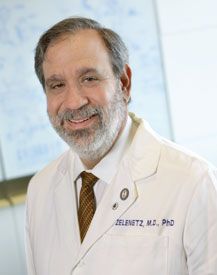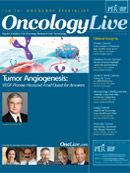Publication
Article
Some Follicular Lymphoma Patients May Benefit From Treatment Delay
Author(s):
Newly-diagnosed asymptomatic follicular lymphoma patients with low tumor burden can have their initial treatment delayed.

Andrew D. Zelenetz, MD
Chief, Lymphoma Service
Department of Medicine
Memorial Sloan-Kettering Cancer Center
Associate Professor of Medcine
Weill Cornell Medical College
New York, NY
Maintenance therapy for follicular lymphoma (FL) remains an option but is not mandatory for patients in remission. The decision for initiating postremission therapy in asymptomatic patients should be based on discussions with the patient, said Andrew D. Zelenetz, MD, chief of Lymphoma Service at Memorial Sloan-Kettering Cancer Center (MSKCC), New York City. In addition, newly-diagnosed patients with low tumor burden can have their initial treatment delayed, since living with asymptomatic disease is similar to being in remission.
“Taking a bird’s-eye view, the quality of life for FL patients who are asymptomatic and living with their disease is similar to that of patients in remission. No maintenance therapy has been shown to have an effect on transformation of the disease or on overall survival [OS],” Zelenetz told attendees at the National Comprehensive Cancer Network 6th Annual Congress on Hematologic Malignancies.
Follicular lymphoma is an indolent B-cell lymphoma that accounts for about 25% of patients with lymphoma in the United States. “Consultations for FL are the longest ones in my practice,” Zelenetz said. “The disease has a long natural history, with a median survival of twelve to sixteen years. Survival has been dramatically improved due to rituximab, but relapse is inevitable over time.”
The decision to initiate therapy in an asymptomatic patient basically falls to patient preference. “From the patient’s perspective, there are two camps: ‘I can’t live my life fully knowing I have active lymphoma,’ or, ‘I feel fine now. You will treat me when I need it,’” Zelenetz explained.
Although a number of clinical trials using different regimens have shown that maintenance therapy after chemotherapy with or without rituximab with either radioimmunotherapy or rituximab dramatically improves progression-free survival (PFS) in FL, no therapy has shown a significant improvement in OS, which would be the gold standard. These trials include EORTC, SAAK, PRIMA, RESORT, and FIT. “Delaying therapy is effective,” Zelenetz said.
Using the PFS endpoint in clinical trials is not as optimal as OS. Achieving improvement in PFS delays the time to initiating the next therapy, but treatment may increase resistance to further treatment, and the impact of PFS on quality of life has not been explored, Zelenetz told attendees. Achieving improvement in OS would preserve future treatment options and delay the potential toxicities of subsequent treatments.
"Treatment decisions are currently based on clinical trials using PFS as an endpoint, but PFS is not the ideal surrogate,” Zelenetz noted. “We need better surrogate markers to predict the depth and quality of remission,” he stated.
Newly diagnosed patients who require treatment are those with symptoms, massive disease (ie, tumor burden >3 cm), cytopenia, concurrent disease transformation, compromised end-organ function, and who are candidates for ongoing clinical trials.
“Please do not treat every newly diagnosed patient with FL,” Zelenetz told the audience during a question-and-answer session. “Four prospective randomized clinical trials that have compared treatment versus observation in newly diagnosed asymptomatic patients (ie, candidates for observation) failed to show improved OS with chemotherapy.”
Disease proliferation is currently being studied at MSKCC as a marker for when to initiate treatment of FL. The technique used is a quantitative assessment based on image analysis of MIB-1/Ki-67 staining [Kedmi et al. Blood. 2010;116(suppl abstr 4149)]. Studies showed that median time to need for treatment was 5 years in FL patients with disease proliferation <30%, while median time to treatment initiation was 18 months in those with disease proliferation >30%.
In the current healthcare environment, cost of therapy is an important consideration. Cost of single-agent rituximab, the mainstay of FL treatment, is about $36,000 per year.
“If this treatment has no impact on OS, then the cost of quality-adjusted life years will be tens of millions of dollars. Currently, we have the luxury of using therapy that doesn’t impact OS, but I can’t predict the future. It might be difficult to get paid for maintenance rituximab [in the future],” Zelenetz said.










